Monday, September 14, 2015
Podcast: Your Brain on Two Legs with Antonia Malchik
Tuesday, January 27, 2015
Talking Headways Podcast: Free Ranging Kids and Uber Data
This one below is the last full pod from Tanya and me. In it we talk about free range kids and whether the Uber data dump is just a PR move or will actually help transportation planners. If you haven't been listening to us, hopefully you will enjoy it. You can find us on iTunes and Stitcher as well if you wish to subscribe.
Monday, July 11, 2011
Going Car Free in San Francisco
I sold my beloved Volkswagen Jetta I nicknamed "The Green Goblin" on Saturday. There have been many good times in that car that I've had for 12 years. It's been across the country a few times, was put in a classified ad as a part of a prank war in college that had people calling and asking if my brand new Jetta was for sale for just $2,000 and been splashed by cattle poo flying from a cattle car in Colorado. Its also served as sleeping quarters outside the four corners and been across the great state of Nevada on Highway 50 at speeds I probably shouldn't mention.
I've lived in San Francisco with the Green Goblin for 5 years and it served me well. I was able to take people around the city that came for a visit and go on day trips around the region and city to places I couldn't easily get without it and generally on a whim. There are many benefits to owning a car, generally the mobility they provide is excellent and because i'm a city planner I like to know my surroundings, including random streets and quirky places that you might not know about otherwise.
Monday, May 23, 2011
How to Free the Market and Reduce VMT - Austin's West Campus
To get there I had to walk through West Campus every day. I often thought that it was underdeveloped and a bit ragged and would dream about how things could change with a little development on my ride home either on the #1 or the #5. That dream seems to have come true, perhaps a bit more than even I thought possible.

In Austin if you heard West Campus in the first half of the 2000s, you might automatically think of the dense neighborhood West of the University full of frats, sororities, and kids with extra money to spend in order to live closer. If you had less cash, you lived North, South, or on Riverside. By the time I left, the city had finally upzoned the neighborhood, much to the chagrin of some neighbors that lived in the area, to allow redevelopment of properties that had fairly poor upkeep due to the captive audience of students and the very limiting height restrictions against heavy demand. I found that a post by the Old Urbanist was very informative on this point and I didn't realize it matched that until today.
Basically, the rent was high but much of the quality was horribly low. When looking for an apartment one time I remember this one place called the Sandpiper. It was one of those old motel looking complexes. For $850 a month you could get the worst two bed room in West Campus. And that was back in 2002.
As Chris Bradford at the Austin Contrarian shows, there was a lot of development that took place and the census shows that the area had really high growth rates. So high in fact that recently there have been rumblings as to whether the infrastructure could handle all the development. Well after the rezoning it seemed like there was a new crane in the sky each month. This led to around 3,700 new residents according to Chris' calculations.
At that same time, Riverside which was a popular area for students when I was in school seemed to be declining in population as a whole losing over 2,000 residents. Additionally, ridership on the West Campus bus has gone up while overall Riverside ridership has dropped.

According to numbers provided by Capital Metro, (thanks to JMVC) ridership in the fall, which has greater ridership than spring, has increased for the West Campus bus by ~1,200 students a day between 2006 and 2010 while the Riverside buses have lost about ~880. Obviously correlation is not causation but you can make a pretty good bet that there was some sort of shift happening. And it wasn't just coming from Riverside, but probably all areas of the city where students were living. Given the rise of 3,700 residents in West Campus, you would think there would be an even greater ridership bump on the West Campus Bus. But a lot of the new folks probably now just walk or bike.
But what else does the shift mean? Well for one thing I think that West Campus gives us a perfect example of how zoning close to Downtowns in major cities can stifle what the market actually wants to provide. Given the choice, I don't know of any college students that wouldn't love rolling out of bed five minutes before class (8am or otherwise) with the ability to get to class on time because they just had to walk or bike quickly. Additionally, there are a lot of people that want to live in proximity to great neighborhoods just outside of downtown in most cities.
But that's also another piece of the regional and national puzzle, if there was a shift from Riverside to West Campus of 800 former Riverside riders or so, that is likely a huge reduction in VMT. Mostly because if you live on Riverside, you own a car and have to drive everywhere. Though the grocery store is close to many of the apartments aimed at students, you couldn't just walk to the library on campus to study or go to parties in West Campus Friday nights. Driving was the only option. Not to mention that the bus passenger miles were much higher going to school.

Checking the Walkscore for Riverside and West Campus, you get an idea of what happens. As you can see below, the Walkscore for Riverside is 56 with the neighborhood the 40th best in Austin. That means lots of driving. Over in West Campus, the Walkscore is 86, second highest in the region. Imagine the VMT difference of those 3,700 new residents now living in West Campus who probably walk to Double Dave's for some pizza rolls rather than driving there.


And I didn't have a lot of time to look at it, but if those 3,700 residents moved out of housing in Riverside and other student areas, and the demographics of those areas changed. Does that mean that these areas became more affordable? Did the rents change? That would be interesting to look at as well.
Ultimately I think this is a lesson for other cities as well. Folks like Lydia DePillis in DC arguing against the height limit should not look to Austin's future plans, which looks like more skyscrapers on the way, but rather to what they've already done with changes in zoning that freed up the market in West Campus. Additionally, the Georgetown folks could learn from this as well.
Austin can learn from itself too, as Chris discussed in his post about the Suicide Pact. Not only is it about schools and kids, but its about quality of life for the region as a whole. Reductions in VMT will come when people are able to live where they want. There's a high demand for walkability and proximity to work and less time spent in cars. In that sense, people already want to do the right thing, we're just not letting them.
Capital Metro UT Shuttle Data Extra...

Thursday, August 19, 2010
11:30 PM Tuesday Night Times Square
It's so busy, nobody ever goes there anymore...

Don't forget in the daytime
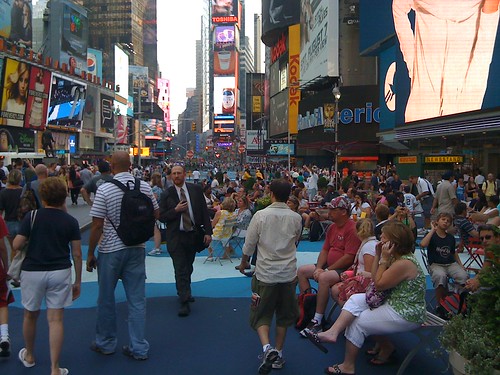
Apartments for cars near the Streetsblog offices
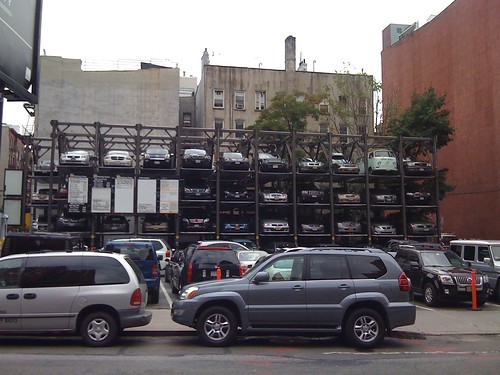
Your friendly bike lane taker uppers
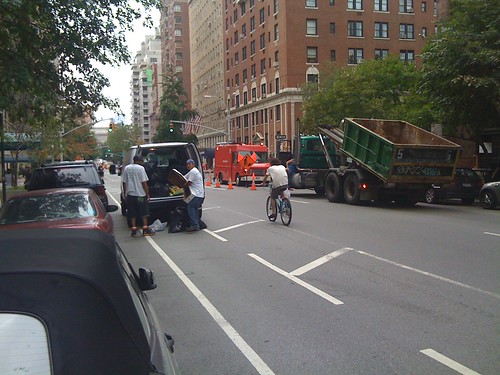
Reminds me of the Netherlands. Needs less fire escape
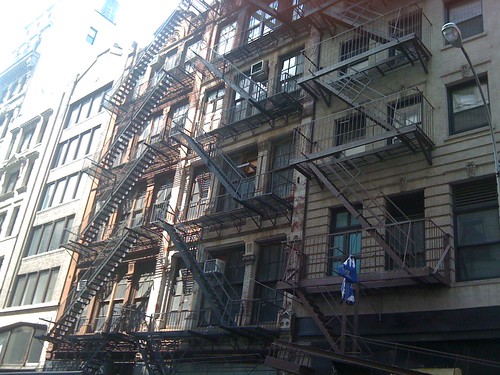
Thursday, July 23, 2009
For Sale Signs
H/T On the Block
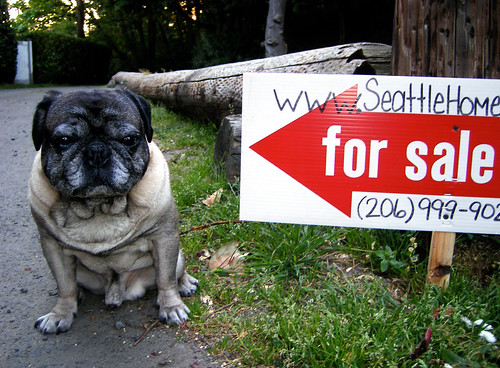 Flickr photo by Zoomar
Flickr photo by Zoomar
Monday, July 6, 2009
LaHood on the Silly Juice?
"We cannot let the cynicism of old ideas get in the way of what people really want," LaHood said about his vision of Americans on foot, on bikes and in trains and buses. How about letting the facts on the ground get in the way of a well-intentioned pipe dream?
They just can't quite understand why people might want alternatives to thier suffocating cancer/asthma causing habits. But transit and biking is only 2.5% of trips they say. There's no wonder people can't take transit or walk, because it isn't offered in a competitive fashion to the automobile trip. When it is, people take it. According to the CTOD database, over 40% of people living near Metro Stations in DC walk, bike, or take transit.
These people all need to wake up and stop throwing around these stupid statistics they don't understand. The newspaper industry and it's "Entitled Driving Journalist Syndrome" is dying a slow death because they don't understand there is a whole other world out there people are craving. I for one am glad that Ray is finally speaking for the other half after being ignored for half a century.
Tuesday, June 30, 2009
Creative People Walking to Bowl
I think you have to look at the underlying facts and basic premises of it all. At the most basic level, every city has a creative class, but at what point does being a really lame city hurt you and the generation of big ideas? To me all of these folks have something in common in that they are trying to figure out why there are some places that people like to live more than others. But the boiled down answers aren't so simple as they make them out to be. Different strokes for different folks I guess.
Monday, June 15, 2009
It's a Shame About Ray
It's not about car eradication. However I don't think everyone wants a car.
But if Americans increasingly get around by rail, bus and bicycle, as you’ve planned, who will be buying cars in the future? I think everybody will have an automobile. I think it’s amazing in America when you drive around and look at new homes that are being built, there are three-car garages. I don’t think you’re going to see families with three cars. I think you’re going to see families with one car, possibly two.We've built out our Interstate System, time to fix other things we've neglected:
So much of why we haven't done these things yet seems to stem from a culture of driving in America. Is that really changeable? We've spent three decades building an interstate system. We've put almost all of our resources into the interstate system. This is a transformational president, and the department is following the president's lead. People haven't really been thinking about these things. They have been thinking about how to build roads, how to build interstates, how to build bridges. People now are thinking differently about where they want to live, how they want to live, and how they want to be able to get around their communities.BTW, how are people liking the random music associations?
Wednesday, May 20, 2009
Trends Favor Core
Most demographic and market indicators suggest that growth and development across the country are moving away from the suburban and exurban fringe and toward center-cities and close-in suburbs.But why?
What's behind this shift? Empty-nesters don't need the big house and don't want to mow the big lawn. High gas prices are making long commutes less practical. The urban renaissance in big cities ranging from New York to Portland, Ore. — and the revival of charming, vibrant downtowns in small cities like Missoula, Mont. — is making the bedroom suburb and the strip mall seem positively dull.
Wednesday, May 13, 2009
72% Are Walking
Sunday, April 26, 2009
Hiding the Good Stuff
It's the new green me.
It's not like I'm going to be surrendering my car now than I'm a city guy, but being without it is increasingly enjoyable. Check out this 28-hour experience that began Thursday morning:
Walk 10 minutes to the Back Bay train station to catch a train to New York. Take the train to New York. Take a cab to visit buddy Jack Bowers in the hospital after surgery. Take a cab to SI in midtown Manhattan for an afternoon of meetings.
Take the subway to Queens for Mets-Padres. Take the subway to Manhattan after the game. Walk to Penn Station. Take the train back to Boston. Walk the 10 minutes home. Not an unpleasant trip on any of the legs. You people in cities have been hiding how great it is to get along without a car.
H/T Nick C
Thursday, April 23, 2009
Aww Can Not Get Your Ship Out
Parking in "da Noe" is easier than many other parts of the city and really if you live here, its not like you even need to drive. I don't think I have ever seen a time when there isn't a meter available or a spot in that lot across from Martha Bros. Mr. Shoup would be proud.
Saturday, March 28, 2009
The Foot Bus to School
I find it interesting that a small town in Italy is looking to cut greenhouse gases by creating foot buses, groups of kids walking to school together. Seems like a great idea to me. From the New York Times:
They set up a piedibus (literally foot-bus in Italian) — a bus route with a driver but no vehicle. Each morning a mix of paid staff members and parental volunteers in fluorescent yellow vests lead lines of walking students along Lecco’s twisting streets to the schools’ gates, Pied Piper-style, stopping here and there as their flock expands.
Tuesday, February 10, 2009
Imagine This Story Times Millions
The autobahn was a rural network, without segments into and through Germany's cities. This seemed appropriate to Eisenhower, but in Washington, Thomas H. MacDonald and Herbert Fairbank of the U.S. Public Roads Administration (the name of the Federal Highway Administration's predecessor during the 1940's) saw the absence of metropolitan segments as a flaw that made the autobahn a poor model for America's future. Unlike Germany, traffic volumes were high in America where car ownership was widespread. Congestion in America's cities had long been a serious complaint that MacDonald and Fairbank would address in their vision of the Interstate System.We sure tackled that congestion problem...that wasn't really addressed because that wasn't the point.
...MacDonald acknowledged with surprising candor that the urban components of the system were not designed to alleviate urban congestion, except to the extent that they would provide relieve to those motorists for whom the city was an inconvenient obstruction...We all know Lewis Mumford had it right though when arguing against the highway system slashing through cities.
The key to reviving our center cities, Mumford said, "rests on the restoring of the pedestrian scale of distances to the interior of the city, of making it possible for the pedestrian to exist." He added, "We are faced, it is fairly obvious to me, with the blunders of one-dimensional thinking, or thinking very expertly about a single characteristic, a single feature that we are interested in, and forgetting the realities that surround us."
Monday, February 2, 2009
Two Thirds Green, One Third Black
Much different than the 80/20 highways to transit we promote here. 4/5ths Black. Does that mean 4/5ths home ownership?Last Thursday, the Danish government agreed to invest 94 billion kroner ($16 billion) to improve the nation’s roads, railways and bike lanes by 2020.
Traffic Minister Lars Barfoed was quoted by The Copenhagen Post as saying, “The shape of the agreement is clear: two-thirds green, one-third black,” meaning that most of the budget will go towards public transit infrastructure and the rest will be spent on asphalt road projects.
Thursday, December 11, 2008
Epic Sidewalk Fail
Wednesday, December 3, 2008
Monday, December 1, 2008
Missing Something?
1. Carbon pricing
2. Efficiency standards
3. Carbon-free electricity
4. Smart electrical grid
5. Electric cars
The author, Adam Stein notes there are gaps. Most glaring to me, nothing about land use or transit. Nothing about walking or cycling. These are some of the best ways you can personally reduce your carbon footprint. I personally drive only once a week now to visit my Grandmother. When I lived in Austin I drove three or four times a week even though I lived next to the Number 1 bus, the most frequent in the city. Land use matters. But what happens when everyone gets electric cars. Are the freeways all going to suddenly free up?
But how come no one talks about it? Is it really because its not that sexy as Rachel Maddow thinks it is?
Or is it something more? What is the deep seeded want not to take transit or build denser? Part of it I know is our entrenched non market based land use system. It's not like your ultimate mobility is compromised by driving less and walking/biking more with optimal land use. Why are the livable community groups so separated from the enviros on this? I can't quite make it out.
Saturday, November 29, 2008
Oh the Horror!!!
I don't know Phoenix at all so don't have any opinion whether the light rail system there makes any sense (I mean, over and above my general feeling that they should be built everywhere), but I loved this from a hater:Oh the horror!!!You might have to walk blocks!
- I can't wait for all the complaints we'll hear once the temperature is 110 degrees . . . and the riders find no shade (has anyone looked at those useless wings provided for shade?) while waiting and, worst of all, will have to walk blocks to get where they want to go.
H/T SF Bike Blog

